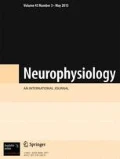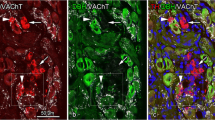Abstract
The organization of sources providing catecholaminergic innervation of the upper thoracic spinal cord was investigated in rats using a sensitive technique specific to tracing connections between catecholaminergic neurons. Large numbers of pontine catecholaminergic neurons belonging to groups A5, A6, and A7 and some single cells from medullary group A1 send out direct projections to the spinal cord. It is postulated that pontine catecholaminergic neurons contributing to innervation of the spinal cord and the medulla are noradrenaline-containing and adrenaline-containing respectively.
Similar content being viewed by others
Literature cited
N. Z. Doroshenko, V. A. Maiskii, and A. G. Kartseva, “New data on the organization of descending hypothalamic pathways obtained by neuronal double retrograde fluorochrome labeling techniques,” Dokl. Akad. Sci. SSSR,282, No. 1, 232–236 (1985).
D. M. Armstrong, C. A. Ross, V. M. Picket,et al., “Distribution of dopamine-, noradrenaline-, and adrenaline-containing cell bodies in the rat medulla oblongata demonstrated by the immunocytochemical localization of catecholamine biosynthetic enzymes,” J. Comp. Neurol.,212, No. 1, 173–187 (1982).
A. J. Basbaum and H. J. Fields, “The origin of descending pathways in the dorsolateral funiculus of the spinal cord of the cat and rat: further studies on the anatomy of the pain modulation,” J. Comp. Neurol.,187, No. 2, 513–532 (1979).
F. Bertrand and A. Hugelin, “Respiratory synchronizing function of nucleus parabrachialis medialis: pneumotaxic mechanisms,” J. Neurophysiol.,34, No. 2, 189–207 (1971).
W. W. Blessing, A. K. Goodchild, R. A. L. Dampney, and J. P. Chalmers, “Cell groups in the lower brainstem of the rabbit projecting to the spinal cord, with special reference to catecholamine-containing neurons,” Brain Res.,221, No. 1, 35–55 (1981).
W. W. Blessing, M. J. West, and J. P. Chalmers, “Hypertension, bradycardia and pulmonary edema in the conscious rabbit after brainstem lesions coinciding with the A1 group of catecholamine neurons,” Circ. Res.,49, No. 4, 949–958 (1981).
J. H. Coote, S. M. Hilton, and A. W. Zbrozyna, “The ponto-medullary area integrating the defence reaction in the cat and its influence on muscle blood flow,” J. Physiol.,229, No. 2, 257–274 (1973).
A. Dahlström and K. Fuxe, “Evidence for the existence of monoamine-containing neurons in the central nervous system. 1. Demonstration of monoamines in the cell bodies of brain stem neurons,” Acta Physiol. Scand.,62, Suppl.232, 1–55 (1964).
A. Dahlström and K. Fuxe, “Evidence for the existence of monoamine neurons in the central nervous system. 2. Experimentally induced changes in the intraneuronal amine levels of bulbospinal neuron system,” Acta Physiol. Scand.,64, Suppl.247, 1–36 (1965).
S. M. Fleetwood-Walker and J. H. Coote, “The contribution of brain stem catecholamine cell groups to the innervation of the sympathetic lateral cell column,” Brain Res.,205, No. 1, 141–156 (1981).
J. B. Furness, J. W. Heath, and M. Costa, “Aqueous aldehyde (Faglu) methods for the fluorescence histochemical localization of catecholamines and for the ultrastructural studies of central nervous tissue,” Histochemistry,57, No. 3, 285–295 (1978).
S. Grillner, “Locomotion in vertebrates: central mechanisms and reflex integration,” Physiol. Rev.,55, No. 2, 247–307 (1975).
T. Hökfelt, K. Fuxe, M. Goldstein, and O. Johansson, “Immunohistochemical evidence for the existence of adrenaline neurons in the rat brain,” Brain Res.,66, No. 2, 235–251 (1974).
P. R. S. Howe, M. Costa, J. B. Furness, and J. P. Chalmers, “Simltaneous demonstration of PNMT immunofluorescent and catecholamine fluorescent nerve cell bodies in the rat medulla oblongata,” Neuroscience,5, No. 12, 2229–2238 (1980).
H. G. J. M. Kuypers and V. A. Maisky, “Retrograde axonal transport of horseradish peroxidase from spinal cord to brainstem cell groups in the cat,” Neurosci. Lett.,1, No. 1, 9–14 (1975).
O. Lindvall and A. Bjorklund, “The organization of the ascending catecholamine neurons systems in the rat brain as revealed by the glyoxylic acid fluorescence method,” Acta Physiol. Scand.,92, Suppl.412, 1–48 (1972).
A. D. Loewy, S. McKellar, and C. B. Saper, “Direct projections from the A5 catecholamine cell group to the intermediolateral cell column,” Brain Res.,174, No. 2, 309–314 (1979).
A. D. Loewy and J. J. Neil, “The role of descending monoaminergic systems in the central control of blood pressure,” Fed. Proc.,40, No. 13, 2778–2785 (1981).
S. McKellar and A. D. Loewy, “Efferent projections of the Al catecholamine cell group in the rat: an autoradiographic study,” Brain Res.,241, No. 1, 11–29 (1982).
R. Y. Moore and F. E. Bloom, “Central catecholamine neurons systems: anatomy and physiology of the norepinephrine and epinephrine systems,” Annu. Rev. Neurosci.,2, No. 2, 113–168 (1979).
L. Nygren and L. Olson, “A new major projection nerve terminals in the central and dorsal columns of the spinal cord,” Brain Res.,132, No. 1, 85–93 (1977).
C. A. Ross, D. M. Armstrong, D. A. Ruggiero,et al., “Adrenaline neurons in the rostral ventrolateral medulla innervate thoracic spinal cord: a combined immunocytochemical and retrograde transport demonstration,” Neurosci. Lett.,25, No. 5, 257–262 (1981).
K. Satoh, M. Tohyama, K. Yamamoto,et al., “Noradrenaline innervation of the spinal cord studies by the horseradish peroxidase method combined with monoamine oxidase staining,” Exp. Brain Res.,30, No. 2/3, 173–186 (1977).
A. J. Smolen, E. J. Glazer, and L. L. Ross, “Horseradish peroxidase histochemistry combined with glyoxylic acid-induced fluorescence used to identify brain stem catecholaminergic neurons which project to the chick thoracic spinal cord,” Brain Res.,160, No. 2, 353–357 (1979).
U. Ungeratedt, “Stereotaxic mapping of the monoamine pathways in the rat brain,” Acta Physiol. Scand.,83, Suppl. 367, 1–48 (1971).
M. J. West, W. W. Blessing, and J. Chalmers, “Arterial baroreceptor reflex function in the conscious rabbit after brainstem lesions coinciding with the A1 group of catecholamine neurons,” Circ. Res.,49, No. 4, 959–970 (1981).
K. N. Westlund, R. M. Bowker, M. G. Ziegler, and J. D. Coulter, “Descending noradrenergic projections and their spinal termination,” in: Descending Pathways to the Spinal Cord, H. G. J. M. Kuypers and G. F. Martin, eds., Elsevier, Amsterdam, (1982), pp. 219–238.
R. P. Jezierski and R. M. Bowker, “A retrograde double level tracing technique using horseradish peroxidase and the fluorescent dye 4,6-diamidino-2-phenylindol-2 HC1 (DAPI),” J. Neurosci. Methods,4, No. 1, 53–62 (1981).
Additional information
A. A. Bogomolets Institute of Physiology, Academy of Sciences of the Ukranian SSR, Kiev. Translated from Neirofiziologiya, Vol. 18, No. 4, pp. 503–512, July–August, 1986.
Rights and permissions
About this article
Cite this article
Doroshenko, N.Z., Maiskii, V.A. Bulbar and pontine sources of catecholamine innervation of the rat spinal cord investigated by monoamine fluorescence and retrograde labeling techniques. Neurophysiology 18, 367–374 (1986). https://doi.org/10.1007/BF01052806
Received:
Issue Date:
DOI: https://doi.org/10.1007/BF01052806



